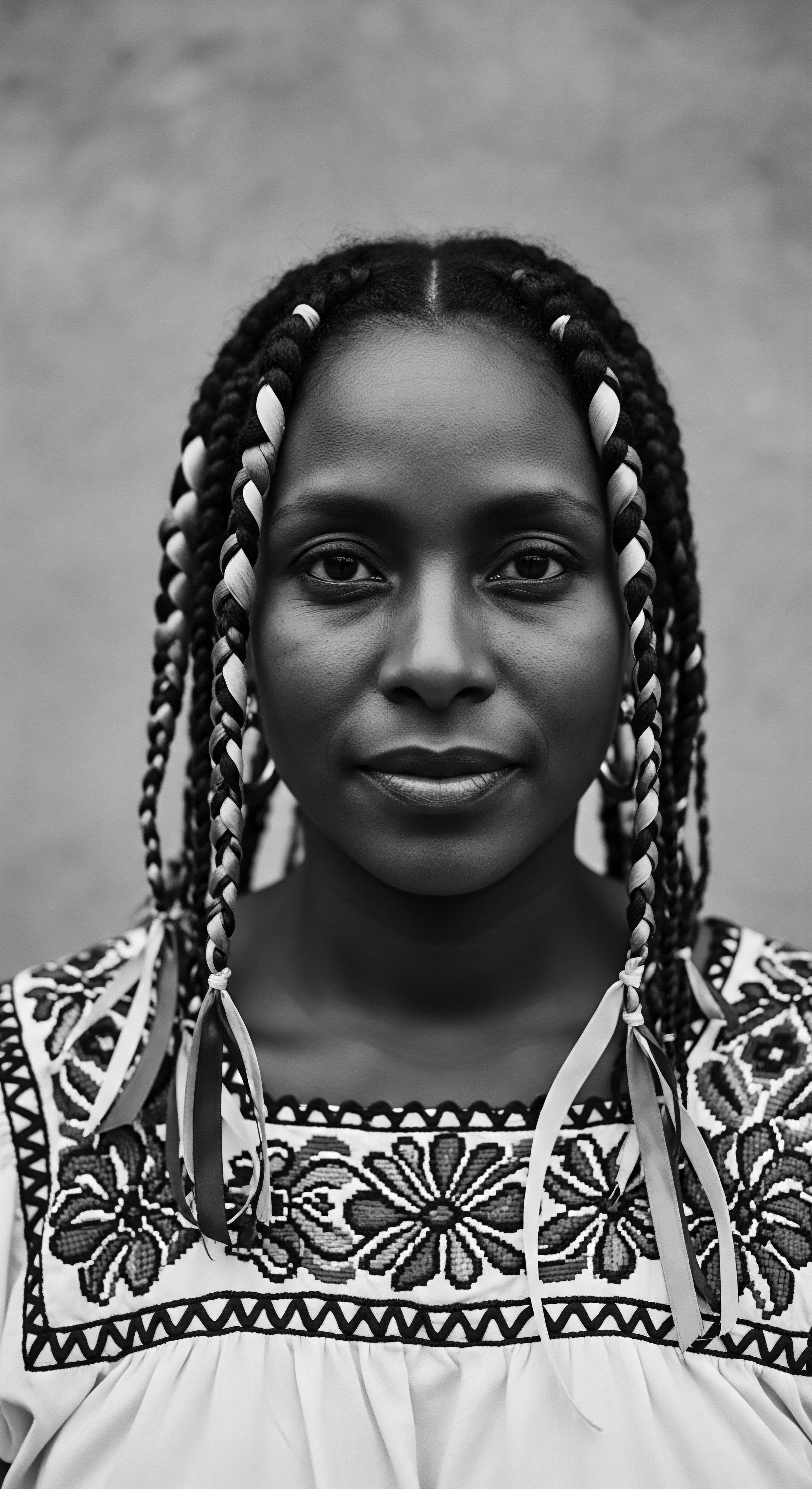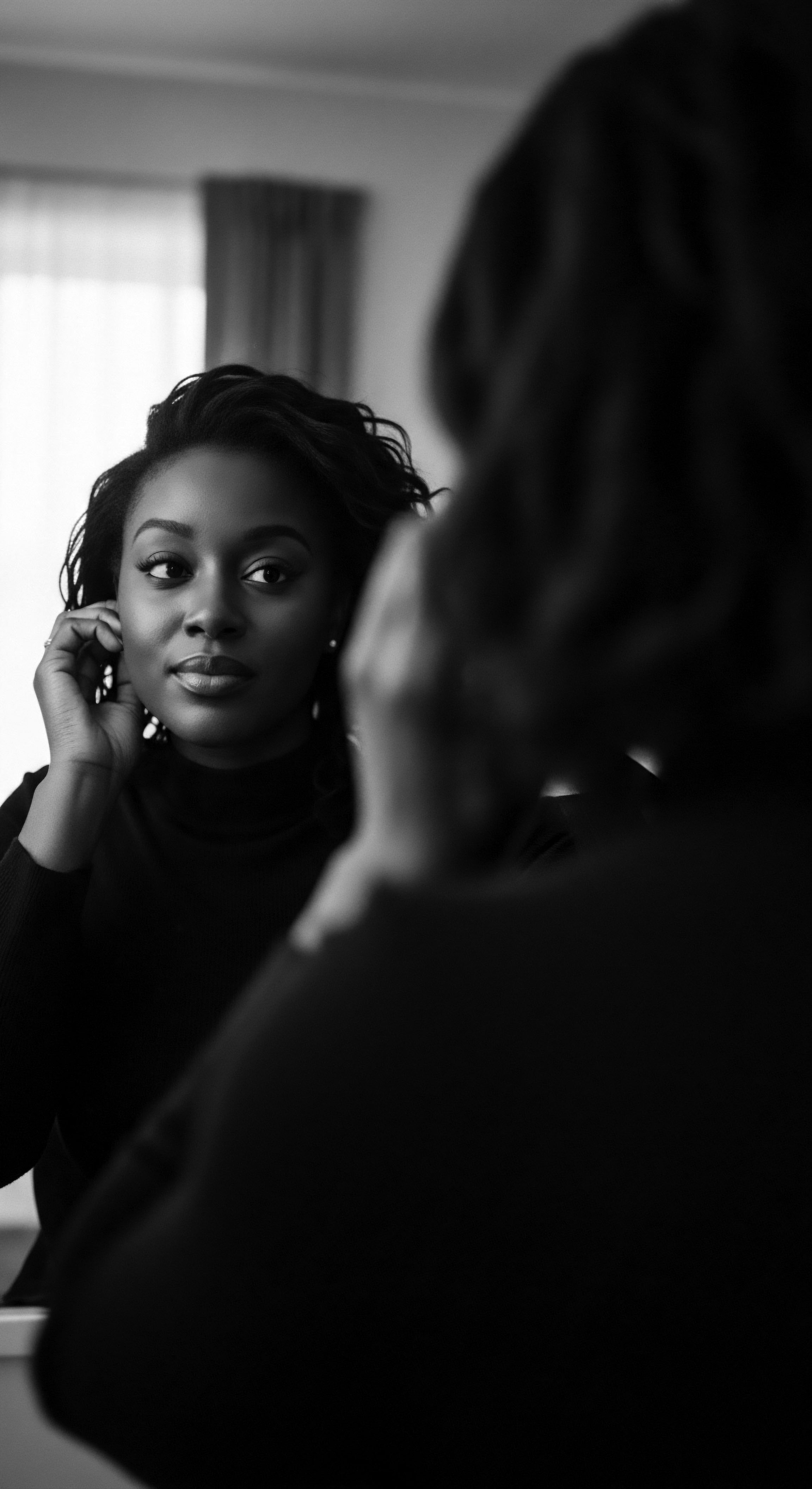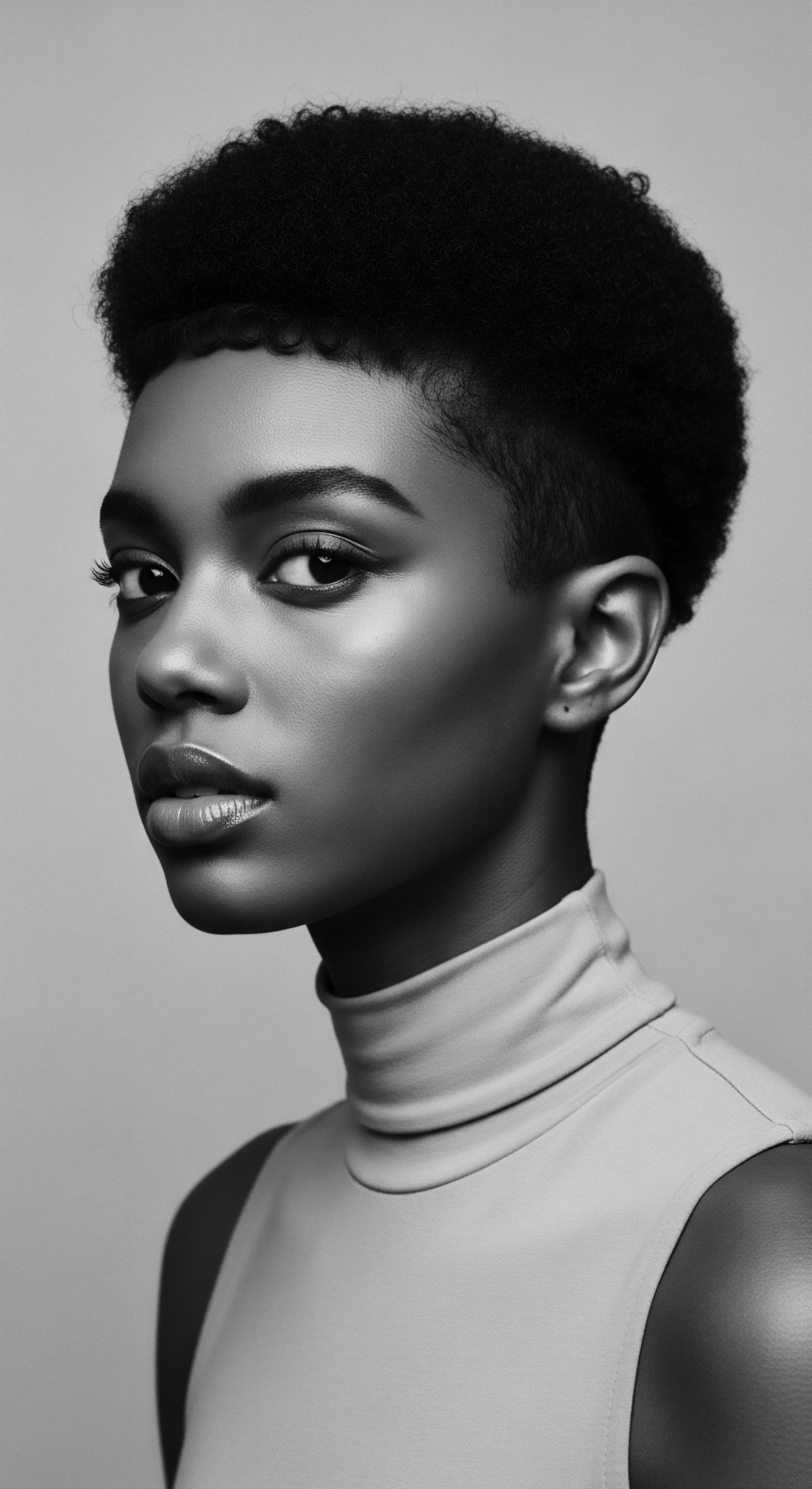
Roots
The very strands of our hair, particularly those blessed with the remarkable coils and bends of textured forms, hold within them a profound ancestral whisper. Each curl, each wave, every defiant kink carries the echoes of journeys, the resilience of generations, and the stories of kin who came before. This heritage, so intimately tied to personal identity and collective memory, often found its passage through the tender touch of hands, the rhythm of communal braiding sessions, and the quiet wisdom shared across laps on sun-drenched stoops or under moonlit skies.
How, then, might the sprawling, digital gathering spaces of our modern age contribute to this sacred act of transmission? Can online communities truly strengthen the intergenerational sharing of hair heritage, keeping these vital currents flowing for those who seek to connect with their ancestral crowns?
Consider the elemental biology of textured hair, a marvel shaped by eons and environments. Its distinctive helical structure, often a tight helix or a more open curl, presents a unique challenge and a singular beauty. The points where the hair shaft bends are naturally more delicate, making it more prone to breakage compared to straighter textures. This inherent characteristic meant that ancestral care practices were not merely about adornment; they were about preservation, about understanding and working with the hair’s natural inclinations.
From the earliest communal gatherings, knowledge of moisturizing concoctions, protective styling, and gentle handling became vital. This understanding, born from observation and necessity, became a part of the living heritage.
Textured hair, with its unique helical structure, carries ancestral stories and physical predispositions that shaped traditional care.

Hair Anatomy and Ancestral Views
The very physiology of textured hair, with its elliptical cross-section and irregular cuticle layering at each bend, offers insights into why certain care traditions arose. This shape, unlike the rounder, more uniform shafts of straight hair, means moisture escapes more readily. Ancestral communities understood this through direct experience, long before microscopes revealed cellular structures.
They saw dryness, they observed breakage, and they responded by developing systems of care that prioritized hydration and protection. The wisdom of applying natural oils and butters, of braiding and twisting hair to safeguard its ends, arose from a deep, empirical understanding of these inherent characteristics.
In many pre-colonial African societies, hair was not a mere biological outgrowth; it was a living extension of the self, imbued with spiritual significance and serving as a complex marker of identity. The very act of caring for hair was a ritual, often performed by elders for the younger generation, cementing bonds and transmitting knowledge. Hair styles could indicate a person’s tribe, social status, age, marital status, or even their spiritual beliefs. The intricate patterns of cornrows, for instance, were more than designs; they were visual languages, carrying messages and stories.

Traditional Lexicon of Textured Hair
The language used to describe textured hair and its care was, and remains, rich and descriptive. Terms like “kinks,” “coils,” “waves,” and “curls” capture the tangible reality of these hair patterns. Beyond these descriptive terms, historical vernaculars often held deeper, more spiritual connotations.
Consider, for a moment, the concept of hair as a “crown.” This idea, present in numerous African and diasporic cultures, positions hair as a sacred adornment, a link to the divine and to one’s lineage. It speaks to reverence, to a knowing that this hair is a gift, a symbol of sovereignty.
- Shea Butter ❉ A rich, creamy substance sourced from the nuts of the African shea tree, historically used for its deeply moisturizing and protective qualities on both skin and hair. Its regular application protected strands from environmental stressors.
- Chebe Powder ❉ Originating from Chadian communities, this finely ground mix of seeds and other botanicals has been traditionally used to condition hair, reduce breakage, and support length retention, often applied as a paste.
- Wide-Tooth Comb ❉ A simple yet indispensable tool, traditionally crafted from wood or bone, revered for its ability to gently detangle coiled hair without causing damage or undue stress to the delicate strands.
The classifications we use today, like numerical typing systems for hair texture, are modern attempts to categorize what ancestral peoples understood through embodied knowledge and observation. These older understandings were often rooted in the hair’s lived experience, its behavior, its response to moisture and touch, rather than a sterile scientific taxonomy. The methods for preparing ingredients, the timing of wash days, the social dynamics of communal styling sessions—all of these were integral parts of the “code” of textured hair, passed down not through manuals, but through presence and participation.

Ritual
The transformation of hair, from its natural state to an expression of cultural artistry, always held a sacred resonance. The process of styling textured hair, particularly in Black and mixed-race communities, has historically represented far more than mere aesthetics. It embodied a profound ritual, a communal gathering, a space where stories flowed freely, and wisdom, often whispered or sung, passed from one generation to the next.
In this unfolding of tradition, how do the burgeoning online communities, with their screens and algorithms, truly participate in this tender act of transmission? Can they replicate, or even augment, the deeply personal, tactile wisdom historically conveyed through these intimate hair rituals?
Centuries before the advent of digital platforms, hair care was a deeply personal, often multi-day event. “Wash days” in Black households often began in the morning and stretched into the evening, becoming a shared experience between mothers, grandmothers, aunts, and daughters. It was a time for detangling, conditioning, braiding, and setting, but also a time for conversation, for teaching, for storytelling.
The knowledge of how to handle delicate coils, the precise amount of oil to use, the tension needed for a protective braid – these were lessons absorbed not through explicit instruction alone, but through observation, repetition, and the patient guidance of an elder’s hands. This is the tender thread of heritage, spun through the quiet dignity of care.

Protective Styling as Ancestral Ingenuity
Protective styles, such as cornrows, braids, and twists, are not contemporary trends; their roots extend thousands of years into African cultures. These styles were originally developed as practical solutions for managing and preserving hair in diverse climates and during long journeys. They served as a shield against the elements, minimized manipulation, and kept the hair neatly contained. During the transatlantic slave trade, the significance of these styles took on a new, profound meaning.
Enslaved African women, for instance, ingeniously braided rice seeds into their hair before being forcibly transported, a poignant act of cultural preservation and survival. This single act speaks volumes about hair as a repository of knowledge and a means of resistance.
The act of styling was often a communal activity, a social anchor. Mothers, daughters, and friends would gather, their fingers interlacing strands, their voices sharing tales of resilience, community news, and family history. This was a classroom without walls, a living library where the techniques of hair artistry were inseparable from the narratives of survival and cultural identity. The rhythm of the braiding, the shared laughter, the comforting scent of hair grease or natural oils – these sensory experiences cemented the lessons in ways a mere instruction could not.
Traditional hair rituals, especially protective styling, were communal acts of cultural preservation and wisdom transfer.

Digital Realms as New Gathering Spaces
The digital age has introduced new spaces for these hair care rituals. Platforms like YouTube and Instagram have emerged as virtual salons, where individuals share their hair journeys, offer tutorials, and discuss products. This shift has allowed for a global sharing of techniques and experiences, democratizing access to knowledge that might have once been confined to specific households or geographic regions.
A young person in London can learn a Bantu knot technique from a content creator in Lagos, or a twist-out method from someone in New Orleans. This cross-cultural dialogue, mediated by screens, broadens the reach of hair heritage.
Yet, this digital transmission possesses its own unique texture. The tactile, sensory elements of traditional learning — the feeling of a grandmother’s gentle tug, the communal hum of a busy salon, the shared aroma of ancestral ingredients — are necessarily absent from the screen. While online tutorials can break down complex styles into manageable steps, they cannot fully replicate the nuanced guidance of a seasoned hand, nor the spontaneous storytelling that accompanies the physical act. The challenge, then, rests in how online communities can bridge this experiential gap, how they can foster a sense of the deeply personal connection that lies at the core of hair heritage.
| Traditional Modality Direct tactile teaching from elder to youth |
| Online Community Analogue Video tutorials demonstrating precise hand movements |
| Traditional Modality Oral storytelling during styling sessions |
| Online Community Analogue Discussion forums, shared personal narratives, live Q&A sessions |
| Traditional Modality Communal gathering in homes or salons |
| Online Community Analogue Virtual meet-ups, online groups, shared "wash day" challenges |
| Traditional Modality Sensory experience of scents and sounds |
| Online Community Analogue Descriptive language, shared product reviews, cultural context creation |
| Traditional Modality The digital realm offers new avenues for knowledge transfer, yet the depth of embodied experience remains a unique strength of traditional heritage practices. |
The dialogue within these online spaces often extends beyond practical techniques. Individuals share personal struggles with hair discrimination, celebrate their natural textures, and collectively challenge Eurocentric beauty standards. These conversations affirm identity and build collective pride, reinforcing the idea that hair heritage is not static, but a living, breathing expression of cultural continuity and self-acceptance.
The “natural hair movement,” significantly amplified by social media, serves as a powerful testament to this collective reclamation of identity. It shows how digital platforms can be powerful tools for fostering a sense of belonging and mutual support among those seeking to reconnect with their ancestral hair practices.

Relay
The enduring vitality of hair heritage, particularly within Black and mixed-race communities, stems from its constant relay across generations. This passing of the torch, from the tender touch of a grandmother’s hands to the modern-day scroll of a digital screen, represents a continuous dialogue with the past. The central question remains ❉ how effectively do online communities truly participate in this relay, transmitting the profound cultural and historical significance of textured hair? Are they merely repositories of information, or do they truly strengthen the living connection, fostering a deeper understanding that transcends superficial trends?
Online spaces, by their very nature, allow for the documentation and dissemination of cultural practices on an unprecedented scale. Digital archives and platforms gather oral histories, images, and texts that might otherwise be lost. Consider, for instance, the emergence of initiatives like the Black Beauty Archives, a digital and physical library that meticulously collects vintage beauty products, media, recorded oral histories, and transcribed beauty rituals related to Black women from the 1950s to the present.
Camille Lawrence, its founder, recognized the absence of a comprehensive reference for Black beauty history, creating a resource for discovering and sharing Black history through the beauty rituals that facilitate the transmission of wisdom. This archival work helps to solidify a collective memory, making historical practices accessible to a global audience, fostering a sense of shared identity and legacy.

Digital Platforms as Living Libraries
The shift from solely oral or direct transmission to digital formats presents both opportunities and challenges. While the immediacy of video tutorials offers a visual guide to intricate styling techniques, the depth of cultural context, the stories behind each braid or twist, require more thoughtful engagement. Social media platforms, for all their speed, have demonstrated an unexpected capacity to function as living libraries of heritage.
Individuals upload videos demonstrating styles like cornrows, Bantu knots, and locs, often explaining the historical background and cultural significance of each. These virtual exchanges extend the reach of ancestral wisdom far beyond geographical boundaries, inviting a global community into the narrative of textured hair.
The impact of this digital relay extends beyond practical knowledge. Online communities serve as vital spaces for identity formation and affirmation. For many young Black women, particularly those embarking on their natural hair journeys, these communities offer support in overcoming societal judgment and navigating familial norms that might push for chemically straightened hair. In a study by Johnson et al.
(2017), researchers found that millennial naturalistas exhibited more positive attitudes toward textured hair compared to other women, suggesting that online communities contribute to a generational shift in self-perception and cultural pride. This highlights a powerful aspect of the digital relay ❉ it’s not just about teaching techniques, but about nurturing a sense of self-acceptance and cultural belonging.
Online communities serve as vital digital archives and spaces for identity affirmation, transforming how textured hair heritage is perceived and shared across generations.

Connecting Global Threads of Heritage
The global reach of the internet facilitates connections among diasporic communities, allowing for the sharing of diverse experiences within the broader Black hair heritage. A woman in Brazil might discover commonalities in hair care practices with someone in Ghana or Jamaica, fostering a deeper understanding of the collective journey. This shared digital space allows for a fluid exchange of ancestral wisdom, adapting traditional methods to contemporary contexts. The conversations often touch upon the painful legacy of hair discrimination and the ongoing fight for acceptance, reinforcing hair as a symbol of resistance and liberation.
However, the digital landscape is not without its complexities. The sheer volume of information can be overwhelming, and the commercialization of hair care, often driven by online influencers, can sometimes overshadow the deeper heritage aspects. It becomes paramount for online communities to prioritize the authentic transmission of knowledge, ensuring that the roots of these practices are not diluted by fleeting trends or commercial interests. This requires a discerning eye, a commitment to historical accuracy, and a collective effort to uplift voices that truly embody the ancestral wisdom.
The active participation of elders in online spaces, while less prevalent than younger generations, is a growing phenomenon that promises to strengthen this intergenerational relay. When older generations share their lived experiences and traditional methods directly within digital forums, it adds an invaluable layer of authenticity and depth to the communal knowledge pool. This direct connection, bridging the perceived digital divide, ensures that the wisdom passed down through centuries finds new pathways for continuity, guaranteeing that the vibrant legacy of textured hair heritage continues its journey through the unbound helix of time.

Reflection
The journey through textured hair heritage, from the whispers of ancient practices to the vibrant hum of online communities, truly reveals a living, breathing archive. Each coil and strand, woven with personal narrative and collective history, continues to carry the weight of legacy. The question of whether digital spaces can strengthen this sacred intergenerational transmission finds its answer not in a simple yes or no, but in the nuanced understanding of how these platforms extend the reach of ancestral wisdom, allowing the ‘Soul of a Strand’ to resonate across new frontiers.
We have seen how the intimate rituals of wash days and braiding sessions, once confined to the physical embrace of family and community, now find echoes in the sprawling digital realm. Online communities, for all their virtual nature, serve as vital conduits, collecting fragmented histories, sharing long-held techniques, and, perhaps most importantly, affirming identity for those seeking connection with their unique hair lineage. The self-acceptance and cultural pride witnessed in the natural hair movement, so powerfully amplified by digital platforms, underscore a profound truth ❉ heritage is not merely preserved; it is actively lived, expressed, and continually redefined.
The path ahead involves a conscious commitment to cultivating these online spaces with reverence and wisdom. It means ensuring that the vast digital archive of textured hair knowledge remains grounded in authenticity, that the voices of elders and cultural keepers are uplifted, and that the narratives of resilience and self-love continue to outshine fleeting trends. The challenge calls for a balance, honoring the tactile wisdom of the past while harnessing the expansive reach of the present.
As we navigate this evolving landscape, the goal remains to ensure that the heritage of textured hair, rich with history and spirit, continues its vibrant, unbroken relay for generations yet to come. It is a testament to enduring beauty, profound identity, and the timeless connection to our roots.

References
- BLAM UK CIC. (2022). The history of Black Hair.
- Obé. (2024). Braids of connection ❉ The tradition and community of Black hair.
- Marie Claire Nigeria. (2025). The Black woman as divine ❉ Sacred femininity in African beauty rituals.
- The Kurl Kitchen. (2024). The Cultural Significance Of Natural Hair In Different Communities.
- Lordhair.com. (2023). The Natural Hair Movement and Resurgence of Black Hair Pride.
- Lashley, M. (2020). The importance of hair in the identity of Black people. Nouvelles pratiques sociales, 31(2), 206–227.
- Ellington, R. (2014). The Natural Hair Journey ❉ Social Media Communities on YouTube and the Promotion of.
- Oprah Daily. (2022). The Black Beauty Archives Are Preserving an Important Piece of Black History.
- International Journal of Humanities Social Science and Management (IJHSSM). (2024). Exploring Digital Technologies in Intergenerational Learning within the tribes.
- Afriklens. (2024). African Hairstyles ❉ Cultural Significance and Legacy.
- Obscure Histories. (2024). Ancient Gems ❉ A Historical Survey of African Beauty Techniques.
- Chicago Public Library. (2021). Her Crowning Glory ❉ A Look at Black Hair in History.
- Gusau Journal of Sociology. (2024). digital media and cultural identity ❉ exploring intersections, impacts, and challenges.
- Taylor & Francis Online ❉ Peer-reviewed Journals. (2022). “I am now being who I am and I’m proud of it” ❉ Hair related personal and social identity and subjective wellbeing of older Black women in the UK.
- GW ScholarSpace. (2015). Redefining the Identity of Black Women ❉ “Natural” Hair and the Natural Hair Movement.
